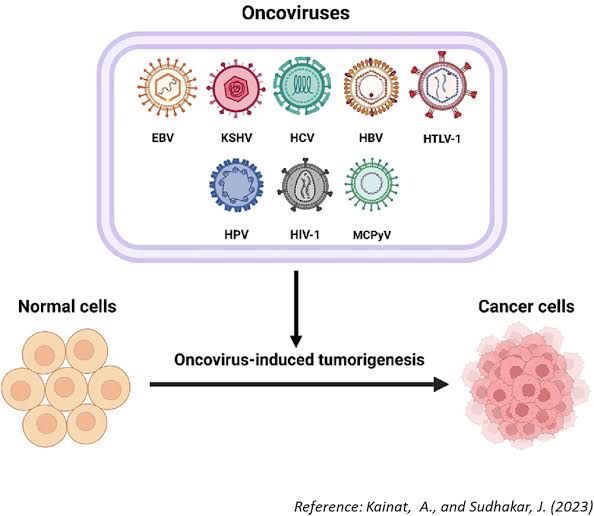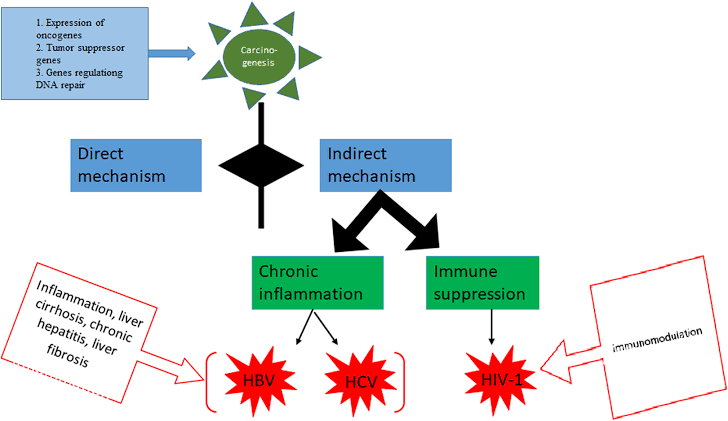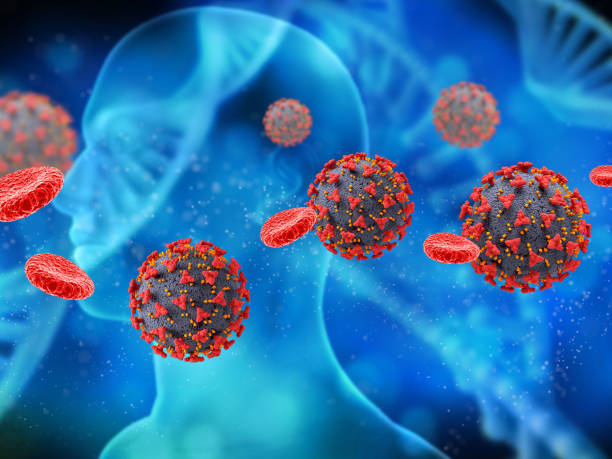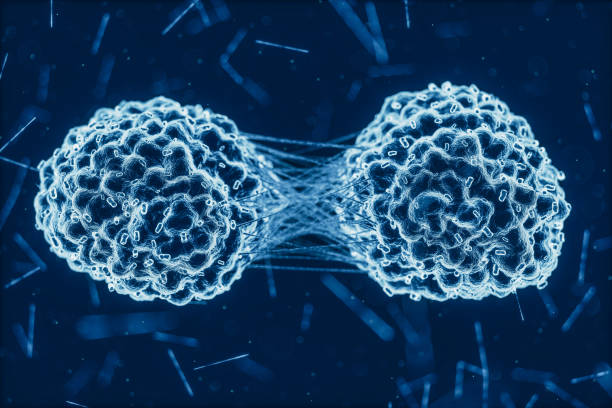“A tumor of the chicken … has been propagated in this laboratory since October, 1909. The behavior of this new growth has been throughout that of a true neoplasm, for which reason the fact of its transmission by means of a cell-free filtrate assumes exceptional importance.”
Francis Peyton Rous, cancer biologist, 1911.
Cancers result from a disruption of the normal restraints on cellular proliferation, which can occur through various mechanisms. Viruses causes a wide range of human diseases, from rabies and smallpox to the common cold. Most of these agents harm the host by replicating within infected cells, killing them, and releasing new virus particles to infect nearby cells.
The cytopathic (cell-killing) effects of viruses, along with their ability to spread rapidly throughout tissue, enable these agents to leave a wide swath of destruction in their wake. However, the peculiarities of certain viral replication cycles may occasionally yield a different outcome. Rather than killing infected cells, some viruses paradoxically force their hosts to thrive and proliferate uncontrollably. Such viruses—often called tumor viruses—can create cancer.

The field of tumor virology officially began over a century ago when, in 1911, Peyton Rous discovered a transmissible agent, a retrovirus now known as the Rous sarcoma virus, which caused sarcomas in chickens. Over the next 50 years, numerous additional viruses were discovered that caused benign tumors and/or cancers in mammals, further strengthening the causal link between viruses and cancer.
The determination that infection by a specific subset of human viruses is the primary cause of a substantial fraction of human cancers is one of the most significant achievements in cancer etiology and intervention. According to the International Agency For Research on Cancer (IARC), approximately 12% (2,300,000 new cases) of global cancers in 2020 were attributable to infectious agents including bacteria, viruses and parasites, with a different geographical distribution between low- and high-income countries . It is estimated that cancer cases due to viral infections represent over 10% of the global cancer burden.
The World Health Organization says Cancer-causing infections, such as human papillomavirus (HPV) and hepatitis, are responsible for approximately 30% of cancer cases in low- and lower-middle-income countries, making tumor viruses of great public health concern.
What are Tumor Viruses?
Tumor viruses, also known as oncoviruses, are viruses that contribute to cancer development. They belong to various families, mainly DNA viruses and RNA viruses, and play a significant role in the etiology of several cancers by altering cellular processes and promoting oncogenesis.
Compared to other viruses, human tumor viruses are unusual because they infect but do not kill their host cells. This allows human tumor viruses to establish persistent infections.
The mechanisms by which these viruses induce cancer are complex, involving interactions between viral proteins and host cell machinery. Some oncogenic viruses are associated with a single tumor type, while others are associated with multiple types of cancer at different anatomical sites.
There are currently seven widely accepted human oncoviruses:
- Human papillomaviruses (HPV)
- Hepatitis B virus (HBV)
- Hepatitis C virus (HCV)
- Epstein–Barr virus (EBV)
- Kaposi’s sarcoma-associated herpesvirus (KSHV) or human herpesvirus 8
- Human T-cell lymphotropic virus (HTLV-1)
- Merkel cell polyomavirus (MCPyV)
These conclusions are based on extensive experimental, clinical, and epidemiological studies.

Tumor Viruses and Their Associated Cancers
Human Papillomaviruses (HPVs)
Human papillomaviruses (HPVs) are DNA viruses with over 200 identified types. They are called papillomaviruses because some types cause papillomas, commonly known as warts. Some HPVs infect only the skin, while others target mucous membranes like those in the mouth, throat, or vagina.
HPV is primarily transmitted sexually, though genital skin contact suffices for transmission. The highest prevalence occurs in developing countries. Most sexually active individuals contract one or more HPV types at some point, with many experiencing repeated infections. While most HPV infections are harmless and clear without intervention, certain high-risk types, particularly HPV-16 and HPV-18, can persist and cause cervical malignancies.
HPV-linked cancers include cervical cancer, anal cancer, and oropharyngeal cancers. HPV oncogenes E6 and E7 are critical drivers of cancer, as E6 promotes p53 degradation and E7 disrupts the retinoblastoma protein (pRb), leading to uncontrolled cell division.
Hepatitis B Virus (HBV) and Hepatitis C Virus (HCV)
HBV and HCV are major causes of viral hepatitis, a liver infection. Both HBV and HCV contribute to hepatocellular carcinoma (HCC) through chronic inflammation and genomic instability. HBV, a DNA virus, and HCV, an RNA virus, are transmitted via blood, unprotected sex, or perinatal routes. While HBV infections often resolve spontaneously, chronic HCV infections are more likely to progress to liver damage or cancer.
Epstein-Barr Virus (EBV)
EBV, a herpesvirus, establishes lifelong infections in B lymphocytes. It is associated with nasopharyngeal carcinoma, Burkitt lymphoma, and Hodgkin lymphoma, particularly in regions like Africa and Southeast Asia. EBV oncogenesis involves viral proteins that interact with host cellular pathways, promoting malignancy.
Kaposi’s Sarcoma-Associated Herpesvirus (KSHV)
KSHV, or HHV-8, causes Kaposi sarcoma, a cancer characterized by vascular tumors, primarily in immunocompromised individuals. It is also linked to primary effusion lymphoma (PEL) and multicentric Castleman disease (MCD).
Human T-Cell Lymphotropic Virus (HTLV-1)
HTLV-1, a retrovirus, is associated with adult T-cell leukemia/lymphoma (ATL). By integrating its DNA into the host genome, it drives clonal expansion of infected cells over decades.
Merkel Cell Polyomavirus (MCPyV)
Discovered in 2008, MCPyV is linked to Merkel cell carcinoma, an aggressive skin cancer. While most infections remain asymptomatic, viral mutations can disrupt host DNA, leading to malignancy.
Human Immunodeficiency Virus (HIV)
Although HIV does not directly cause cancer, its immunosuppressive effects increase susceptibility to other oncoviruses like HPV and KSHV. HIV is associated with Kaposi sarcoma, cervical cancer, and certain lymphomas.
Mechanisms of Viral Oncogenesis
Tumor viruses contribute to cancer development (Oncogenesis) through several mechanisms, including:
- Viral Integration: Oncogenic viruses, such as HPV and EBV, integrate their genetic materials into the host’s DNA, disrupting normal cellular genes and regulatory pathways, which lead to uncontrolled cell growth.
- Oncoprotein Production: Some viruses produce viral proteins (oncoproteins) that interact with host tumor suppressor proteins, such as p53 and Rb, inhibiting their function and leading to uncontrolled cell proliferation. For example, HPV produces E6 and E7 oncoproteins.
- Chronic Inflammation: Viruses such as HBV and HCV can cause chronic inflammation, creating an environment conducive to genetic mutations and cancer development.
- Disruption of Cellular Processes: Viral oncogenes can inhibit apoptosis, alter DNA repair mechanisms, and induce genomic instability, all of which promote tumor development.
- Evasion of Immune Surveillance: Tumor viruses can evade the host immune system, allowing persistent infections that increase the risk of cancer over time.

Therapeutic Implications: Targeting Tumor Viruses
Advances in understanding tumor viruses have led to innovative therapeutic approaches:
- Antiviral Therapies:
- HBV and HCV antivirals, such as Tenofovir, reduce viral replication and lower cancer risks.
- Immunotherapy:
- Vaccines such as the HPV vaccine prevent infection by high-risk viral types.
- Immune checkpoint inhibitors, such as pembrolizumab, enhance the immune response against virus-infected cells.
- Oncolytic Virus Therapy:
- Genetically engineered viruses selectively destroy cancer cells while sparing normal tissues.
- Targeted Therapies:
- Agents targeting viral oncoproteins or activated signaling pathways counteract oncogenesis and prevent tumor growth.
Prevention and Control Strategies
- Vaccination: Vaccines such as the HPV and HBV vaccines have proven highly effective in preventing virus-associated cancers.Expanding vaccination access, especially in low-resource settings, can significantly reduce cancer incidence.
- Screening and Early Detection: Regular screening for HPV-related cervical cancer and HBV-related liver cancer can significantly reduce mortality.
- Public Health Education: Educating the public on vaccination and safe sexual practices can mitigate viral cancer risks.
Future Directions
The future of tumor virology lies in integrating advanced technologies to identify new biomarkers and therapeutic targets. Continued research focuses on:
- Biomarker Discovery: Identifying novel diagnostic and prognostic markers.
- Next-Generation Vaccines: Developing vaccines for other high-risk viruses.
- Multi-Omics Integration: Leveraging genomics, transcriptomics, and proteomics to understand viral oncogenesis.
Conclusion
Tumor viruses exemplify how seemingly simple biological agents can wield profound effects on cellular processes, driving cancer development. From the discovery of the Rous sarcoma virus to the development of vaccines against HPV and HBV, the field of tumor virology has made significant strides. By fostering interdisciplinary collaboration and leveraging technological advancements, we can continue to unravel the mysteries of viral oncogenesis and reduce the burden of these malignancies worldwide.
Further Readings
- Schiller JT, Lowy DR(2021). An Introduction to Virus Infections and Human Cancer.
- Tempera I, Lieberman PM(2021). Oncogenic Viruses as Entropic Drivers of Cancer Evolution.
- Chowdhary S et al.,(2023). Recent Updates on Viral Oncogenesis: Available Preventive and Therapeutic Entities.
- Hassan STS(2022). Tumor Viruses and Their Associated Cancers: Remain on the Track with the Latest Advances.
- Galati L, Chiantore MV, Marinaro M, Di Bonito P(2024). Human Oncogenic Viruses: Characteristics and Prevention Strategies-Lessons Learned from Human Papillomaviruses.
- Weinberg, RA.(2013). The Biology of Cancer (2nd ed.)



